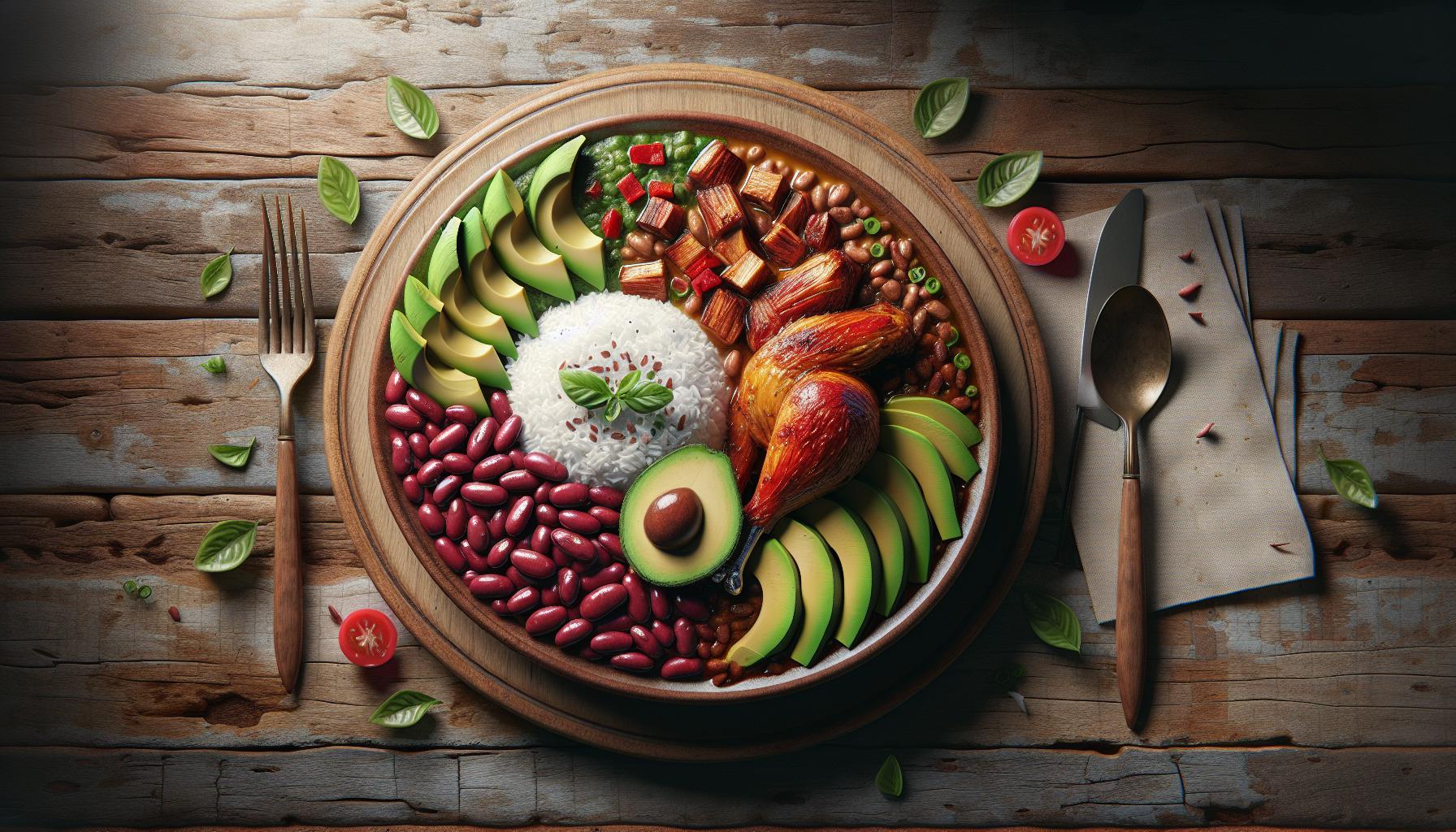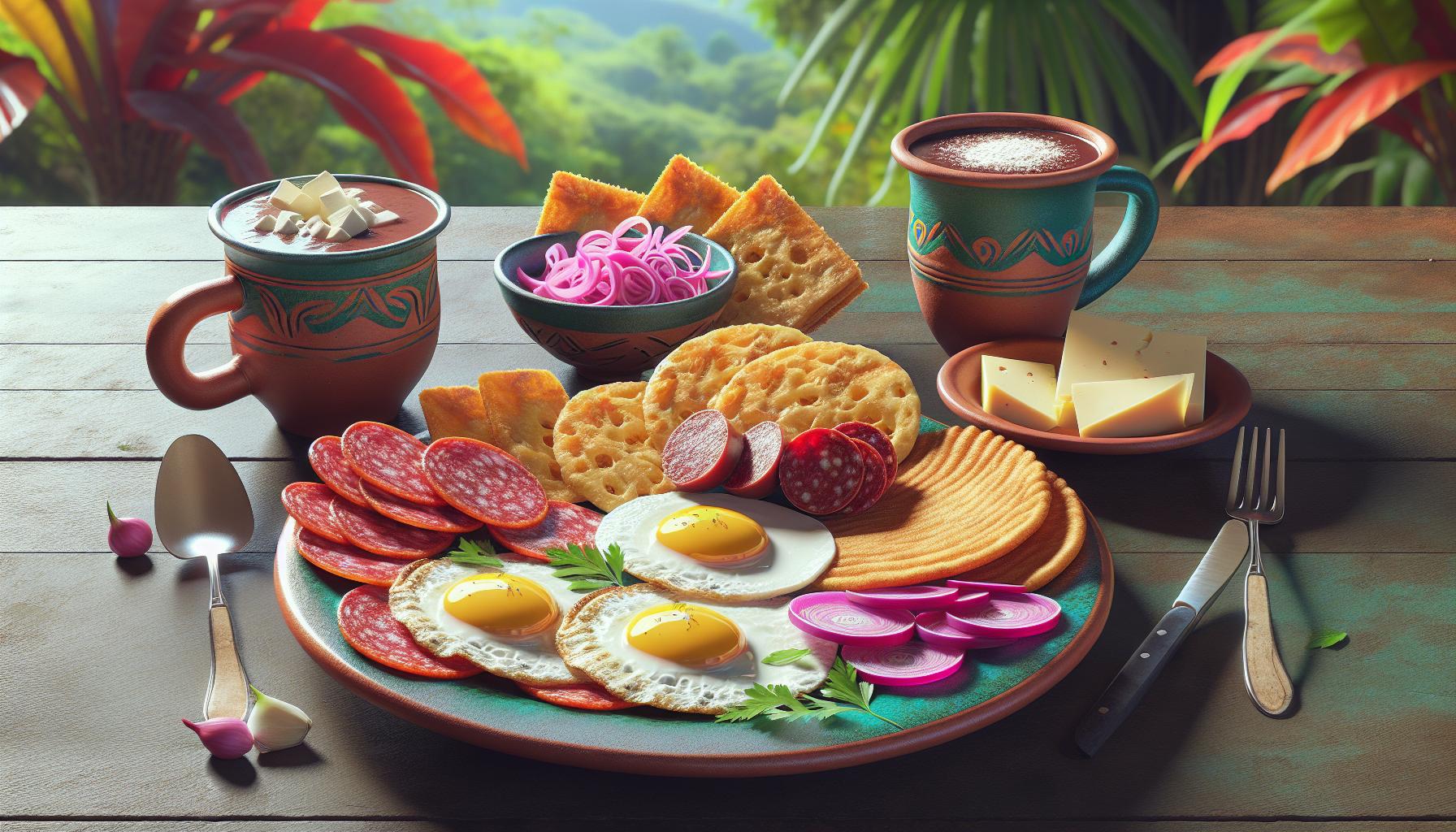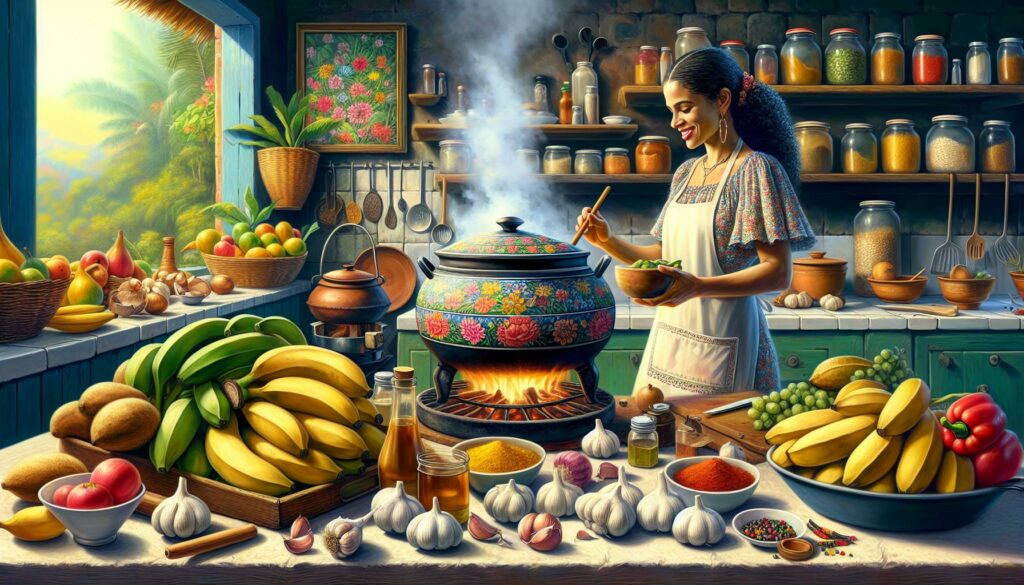Dominican cuisine tantalizes taste buds with its vibrant fusion of Spanish, African and Taíno influences. From the sizzling plantains to the hearty La Bandera (the national dish), Dominican food tells a rich story of cultural heritage through every aromatic bite.
The island’s culinary traditions reflect its warm hospitality where meals aren’t just about sustenance – they’re celebrations of life, family and community. Whether it’s the morning ritual of mangú (mashed plantains) or the weekend gatherings over a steaming pot of sancocho, Dominican food brings people together in ways that transcend the dining table. Each dish carries centuries of tradition while continuing to evolve with modern twists that keep this cuisine exciting and relevant in today’s global food scene.
Dominican Culture Food
A Dominican kitchen combines essential ingredients with specialized cooking tools to create authentic Caribbean flavors. These elements form the foundation of Dominican gastronomy and preserve centuries-old culinary traditions.
Common Ingredients and Spices
The Dominican pantry features staple ingredients that appear in numerous traditional recipes. Rice forms the base of many meals, particularly long-grain white rice for La Bandera Dominicana. Fresh herbs like cilantro, oregano, thyme create aromatic bases for sauces and stews. Garlic, onions, bell peppers comprise sofrito – a seasoning blend central to Dominican cooking. Adobo seasoning contains cumin, oregano, garlic powder infusing dishes with signature flavors. Root vegetables including yuca, ñame, batata add hearty elements to soups and sides. Tomato paste, olive oil, lime juice enhance sauces and marinades.
Essential Cooking Tools
A well-equipped Dominican kitchen contains specific tools for traditional cooking methods. The caldero – a heavy-bottomed pot – cooks rice to perfect consistency. A pilón (mortar and pestle) crushes spices and makes mofongo. The guayo (metal grater) processes coconut, cassava, plantains for various dishes. Cast iron skillets season foods and create the coveted pegao (crispy rice). Wooden spoons prevent scratching cookware while stirring sancochos and beans. Large colanders drain root vegetables and rinse rice. The tostonera flattens plantains for tostones. Pressure cookers speed up the cooking of beans and tough cuts of meat.
Popular Dominican Main Dishes

Dominican main dishes showcase the island’s diverse culinary heritage through hearty combinations of meats, rice, beans, and vegetables. These traditional recipes feature local ingredients prepared with time-honored cooking techniques.
La Bandera Dominicana
La Bandera Dominicana represents the national dish of the Dominican Republic, served daily in homes across the country. This complete meal consists of white rice, red kidney beans, and meat (typically chicken or beef) served with a side of stewed vegetables. The beans simmer in a sauce of garlic, cilantro, onions, and Dominican oregano. Fresh avocado slices complement the dish, adding creamy texture. Dominican cooks prepare the meat by marinating it in bitter oranges, garlic, and oregano before slow-cooking until tender.
Sancocho
Sancocho embodies Dominican comfort food at its finest, combining seven types of meat with root vegetables in a hearty stew. This celebratory dish features plantains, yuca, ñame, potatoes, corn, and various cuts of pork, beef, chicken, and longaniza sausage. Dominican cooks season the broth with cilantro, garlic, and oregano, simmering it for 3-4 hours until the meats tenderize. Families serve sancocho with white rice, avocado, and hot sauce during special occasions or weekend gatherings.
Mangú
Mangú stands as the quintessential Dominican breakfast dish, featuring mashed green plantains topped with sautéed red onions. Cooks boil the plantains until tender, then mash them with reserved cooking liquid and butter until smooth. The signature onion topping marinates in vinegar before a quick sauté, creating a tangy contrast to the creamy plantains. Traditional accompaniments include fried Dominican salami, queso frito (fried cheese), and eggs, forming the complete breakfast known as Los Tres Golpes.
Street Food and Snacks

Dominican street food culture thrives in local markets, street corners, and food trucks across the island. These quick bites showcase the authentic flavors of Dominican cuisine through portable, affordable options that locals enjoy throughout the day.
Empanadas and Pastelitos
Dominican empanadas feature a crispy corn flour shell filled with seasoned ground beef, chicken, or cheese. Local vendors prepare these handheld treats fresh, serving them hot with a side of wasakaka sauce or pink sauce. Pastelitos differ from empanadas with their flaky wheat flour dough, creating a lighter texture. Popular pastelito fillings include:
- Ground beef mixed with sofrito seasoning
- Shredded chicken with bell peppers
- Cheese blended with local herbs
- Mixed vegetables sautéed in Dominican spices
Street vendors cook these pastries in large metal fryers, selling them during breakfast hours through late afternoon at prices ranging from 25-50 Dominican pesos.
Chicharrón and Yaroa
Chicharrón dominicano consists of twice-fried pork belly chunks with crispy skin and tender meat. Local vendors season the pork with oregano, garlic, lime juice, and salt before frying. Yaroa, a Santiago specialty, combines:
- French fries or mashed plantains as base
- Seasoned ground beef or chicken
- Melted cheese blend
- Mayonnaise-ketchup sauce
- Chopped cabbage garnish
Street vendors serve chicharrón by weight, typically 100-200 grams per portion. Yaroa comes in individual containers priced between 150-250 Dominican pesos, making it a filling street meal option.
Dominican Breakfast Specialties

Traditional Dominican breakfast dishes combine hearty ingredients with bold flavors, creating energizing morning meals that reflect the island’s agricultural abundance. These breakfast staples incorporate fresh local ingredients prepared through time-honored cooking methods.
Los Tres Golpes
Los Tres Golpes represents the quintessential Dominican breakfast combination of fried eggs, fried Dominican salami, and fried cheese. Each component delivers distinct textures: crispy-edged eggs with runny yolks, savory slices of salami with a smoky flavor profile, and queso frito (fried cheese) with its golden crust. The trio accompanies mangú, a smooth purée of green plantains topped with pickled red onions. Dominican households serve this protein-rich breakfast with fresh bread rolls called pan de agua alongside strong Dominican coffee.
Chocolate de Agua
Chocolate de Agua stands as a signature Dominican morning beverage made from pure cacao, cinnamon sticks, star anise, and nutmeg. Local cooks prepare this drink by simmering raw cacao with spices in water until it develops a rich consistency. The preparation process involves using a molinillo (traditional wooden whisk) to create a characteristic foam layer on top. Dominican families serve this dairy-free hot chocolate in traditional ceramic mugs alongside root vegetables like yuca or sweet potato. The drink pairs perfectly with pan de agua or johnny cakes for a complete breakfast experience.
Special Occasions and Celebrations
Dominican celebrations center around elaborate feasts that bring families together to share traditional dishes passed down through generations. These gatherings showcase the richness of Dominican culinary heritage with specific dishes reserved for important holidays.
Christmas Food Traditions
Christmas in the Dominican Republic features distinctive dishes like pasteles en hoja, plantain-based tamales filled with seasoned meat wrapped in banana leaves. The centerpiece of Dominican Christmas dinner is roasted pork (lechón asado), prepared with garlic, oregano, bitter oranges marinade. Telera, a sweet potato pudding spiced with cinnamon, cloves, raisins accompanies the main course. Traditional drinks include ponche, made with rum, milk, eggs, spices. The feast concludes with dulces navideños – traditional Christmas sweets like jalea de batata (sweet potato jam) habichuelas con dulce (sweet cream of beans).
Holy Week Dishes
Holy Week celebrations feature meatless dishes that honor Catholic traditions. Bacalao (salted cod) prepared with coconut milk, tomatoes, olives dominates Holy Thursday meals. Guandules guisados (stewed pigeon peas) served with rice offers a protein alternative during this period. The menu includes habichuelas con dulce, a creamy dessert soup made from red beans, coconut milk, sweet potatoes, raisins. Fresh seafood dishes like pescado con coco (fish in coconut sauce) replace meat-based meals. Many families prepare chacá, a corn-based dessert seasoned with cinnamon, nutmeg.
The Art of Dominican Seasoning
Dominican cuisine derives its distinctive flavors from a masterful blend of seasonings that transform simple ingredients into vibrant dishes. The seasoning techniques combine indigenous Taíno methods with Spanish and African influences to create unique flavor profiles.
Sofrito and Sazón
Dominican sofrito forms the flavor base of countless dishes, combining pureed onions, garlic, bell peppers, cilantro, and oregano. Cooks prepare large batches of sofrito to store in glass containers, adding spoonfuls to beans, rice, soups, and stews. Dominican sazón encompasses signature spice blends featuring ground cumin, coriander, adobo, and saffron. Local cooks personalize their sazón ratios based on family recipes passed through generations. The combination of sofrito and sazón creates depth in dishes like sancocho, habichuelas guisadas, and pollo guisado.
Herbs and Aromatics
Fresh herbs play a central role in Dominican seasoning, with cilantro, culantro, oregano, and thyme leading the aromatic palette. Dominican kitchens incorporate whole garlic cloves, sliced onions, crushed peppercorns, and bitter oranges into marinades and braising liquids. Bay leaves add earthy notes to beans and stews, while fresh parsley brightens finished dishes. Local markets display bundles of fresh herbs alongside aromatics like ginger root, which adds warmth to beverages and meat dishes. The careful balance of herbs and aromatics creates the characteristic flavors that define Dominican cooking.
Rice Culture in Dominican Cuisine
Rice forms the foundation of Dominican gastronomy, with Dominicans consuming an average of 126 pounds of rice per person annually. This staple grain appears in virtually every main meal, prepared through distinct cooking methods that reflect regional traditions.
Different Rice Preparations
Dominican rice preparations showcase versatility through multiple cooking techniques. Arroz blanco features perfectly cooked white rice with each grain remaining separate. Moro combines rice with beans or pigeon peas in a single pot, absorbing the flavors of sofrito garlic oregano. Locrio incorporates proteins like cod fish chicken or pork directly into the rice, creating a complete meal. Arroz con maíz pairs rice with fresh corn for a sweet-savory combination. Arroz con leche transforms rice into a creamy dessert with milk cinnamon vanilla. Each preparation requires mastery of the caldero, a heavy-bottomed pot that creates the prized concón (crispy rice layer) at the bottom.
Rice Accompaniments
Traditional Dominican rice dishes pair with specific accompaniments that enhance flavors textures. Habichuelas guisadas (stewed red beans) complement white rice with a rich sauce perfect for mixing. Fresh avocado slices add creamy contrast to rice dishes. Carne guisada (braised meat) provides protein depth while its sauce integrates with the rice. Ensalada rusa (potato salad) offers cool crunch against warm rice. Platanos maduros (sweet fried plantains) balance savory rice preparations with natural sweetness. These accompaniments create the complete Dominican dining experience following time-honored combinations passed through generations.
Sweet Treats and Desserts
Dominican desserts embody a perfect fusion of Spanish colonial influences with tropical ingredients native to the Caribbean. These sweet delicacies showcase the island’s rich culinary heritage through unique combinations of fruits, spices, and traditional cooking methods.
Traditional Dominican Desserts
Dominican kitchens produce beloved desserts that reflect generations of cultural traditions. Habichuelas con dulce, a creamy sweet bean dessert made with coconut milk, features prominently during Lent celebrations. Arepa dulce combines cornmeal with coconut milk, butter, and spices into a dense cake enriched with raisins. Majarete presents a silky coconut corn pudding topped with cinnamon, while dulce de leche cortada transforms curdled milk into a caramelized delight. Classic flan dominates special occasions with its smooth caramel coating and custard base.
Tropical Fruit Treats
Fresh tropical fruits transform into delectable Dominican sweets through time-honored preparations. Dulce de coco creates tender coconut strips candied in brown sugar syrup. Dulce de guayaba pairs guava paste with local white cheese for a sweet-savory combination. Jalao combines grated coconut with honey into chewy candy balls. Dulce de naranja transforms bitter oranges into crystallized citrus preserves. Fresh fruit batidas blend papaya, passion fruit or soursop with milk into refreshing drinks perfect for hot Caribbean afternoons.
Love Passed Down Through Generations
Dominican cuisine stands as a vibrant testament to the nation’s rich cultural tapestry. From the humble caldero to the bustling street food corners this culinary tradition continues to captivate both locals and visitors alike. The masterful blend of indigenous Taíno African and Spanish influences creates dishes that tell stories of heritage preservation and familial bonds.
Today’s Dominican kitchen remains a place where ancient techniques meet modern adaptations while maintaining the authenticity that makes this cuisine unique. Whether it’s a festive holiday feast or a simple family dinner the Dominican table represents more than just food – it embodies centuries of tradition celebration and love passed down through generations.

